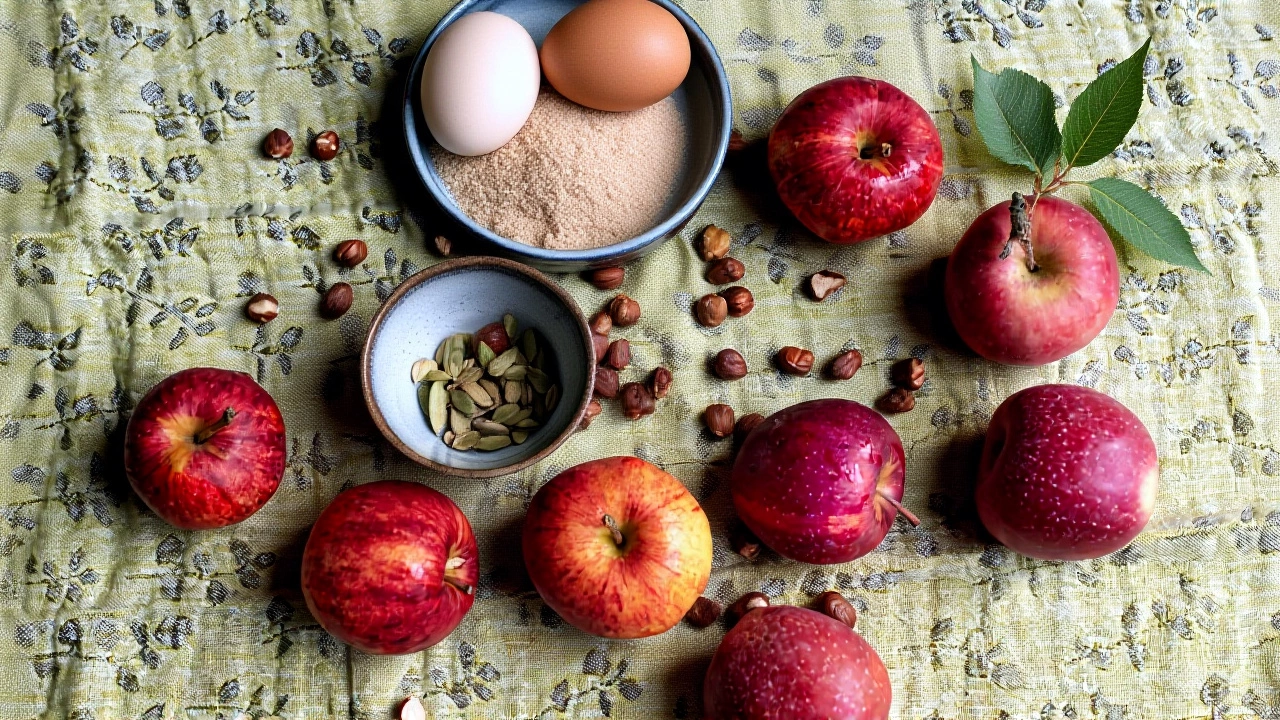When Nigel Slater published his latest Kitchen Diary column in The Observer on Wednesday, November 26, 2025, he didn’t just share a recipe—he offered a quiet moment of warmth against the autumn chill. The dish? An apple and cardamom cake, born from a misty hike in Finland and a pantry full of this year’s harvest. It’s not flashy. No fondant, no ganache. Just tender apples, toasted hazelnuts, and the earthy perfume of freshly ground cardamom, all wrapped in a buttery crumb that smells like home. And in a world racing toward complexity, that’s the real magic.
A Recipe Rooted in Place
Slater doesn’t just write recipes—he writes memories. The cake, he explains, was inspired by a walk through Finnish forests where wild apples hung low and the air carried the scent of woodsmoke and damp earth. Back in his London kitchen, he translated that feeling into something tangible: a cake that doesn’t need embellishment. The method is precise but unhurried. Peel, core, chop. Melt butter. Add apple juice. Let the apples soften until they collapse into jammy submission. That’s not cooking—it’s alchemy.
Then come the nuts. Hazelnuts, toasted in a dry pan until their skins blister and the scent fills the room. Ground fine, they give the cake body without heaviness. Cardamom pods are cracked open, seeds scraped and ground to a fine powder—not just sprinkled, but truly integrated. This isn’t a spice garnish. It’s the soul of the cake. And the sugar topping? Two tablespoons of caster sugar mixed with coarsely ground cardamom seeds, scattered hot over the cake as it cools. That’s the moment the scent blooms. You don’t taste it first—you breathe it.
How It Compares: Slater’s Apple Legacy
Slater’s love for apples runs deep. On his official site, nigelslater.com, you’ll find Apple and Marmalade Tart—puff pastry wrapped around orange-scented fruit—and Apple Fool, a cloud-like dessert of baked apples folded into mascarpone. There’s also a wholemeal version from his book The Christmas Chronicles, with spiced frosting that feels like winter in a slice. But this cardamom cake? It’s different. Less festive, more intimate. It doesn’t demand attention. It waits for you.
The version floating around on Nigella.com, attributed to ‘Welshrarebits,’ is closer to an English apple cake—browned edges, breadcrumbs on top, demerara sugar. But Slater’s Observer version is leaner, more Scandinavian in its restraint. No lemon zest. No vanilla. Just apples, butter, sugar, and the quiet authority of cardamom. It’s a recipe that trusts the ingredients. And the reader.
Why This Matters Now
It’s late November. The UK’s apple harvest, which peaks from September through October, is long over. But the fruit still lingers in storage—crisp, sweet, slightly tart. Slater’s timing isn’t accidental. He’s asking us to use what we have, not what’s trendy. In a time when food media is saturated with viral desserts and 10-minute meals, this cake is a rebellion. It takes an hour. You need patience. You need a good peeler. And you need to care enough to crack open cardamom pods by hand.
The Observer, published by the Guardian Media Group in London, has carried Slater’s column for over two decades. His memoir, Toast – The Story of a Boy’s Hunger, was turned into a film. He’s not just a writer—he’s a cultural touchstone. And this cake? It’s not about fame. It’s about belonging.
What’s Next for Seasonal Baking?
There are no announced events or follow-ups. No cookbook tour. No pop-up bakery. But the rhythm of the seasons will bring this recipe back next autumn. And that’s the point. Slater’s work thrives on repetition—not repetition as boredom, but as ritual. The same apples. The same spices. The same quiet act of baking when the light grows thin.
Look at the numbers: 22cm tin. 180°C. 55–60 minutes. Two tablespoons of sugar for the topping. These aren’t suggestions—they’re instructions from someone who’s tested this a hundred times. No ‘about’ or ‘roughly.’ Just certainty. And in that certainty, there’s comfort.
Behind the Scenes: The Apple Crop of 2025
This year’s UK apple crop was described by growers as ‘glorious’—abundant, with high sugar content after a long, dry summer. Orchards in Herefordshire, Kent, and Somerset reported yields up 18% from 2024. That’s not just good news for cider makers—it’s a gift to bakers. Slater’s recipe is a direct response to that bounty. He’s not importing exotic fruits. He’s celebrating what grew just miles from his kitchen.
And that’s the quiet revolution here: food writing that honors place, season, and patience. Not ‘food porn.’ Not ‘hacks.’ Just a cake. Made well.
Frequently Asked Questions
Why use freshly ground cardamom instead of pre-ground?
Pre-ground cardamom loses its volatile oils within weeks, leaving behind a dull, dusty flavor. Slater insists on cracking pods and grinding seeds fresh because the aroma is bright, citrusy, and slightly floral—essential to the cake’s character. A spice grinder or mortar and pestle takes under two minutes and transforms the entire dish.
Can I substitute hazelnuts with almonds or walnuts?
Yes, but the flavor profile changes. Hazelnuts add a toasty, nutty depth that complements the apples and cardamom without overpowering. Almonds are sweeter and more neutral; walnuts bring bitterness that may clash. If substituting, toast them the same way and grind finely—texture matters as much as taste.
Why does the recipe specify a 22cm spring-form tin?
A 22cm tin ensures the cake bakes evenly without drying out. Smaller tins make it too thick and risk undercooking the center; larger ones make it too thin, leading to overbrowning. The spring-form allows easy release without damaging the delicate crumb—critical for a cake meant to be served plain, with no glaze or frosting.
Is this cake suitable for vegans or those with dietary restrictions?
Not as written—it contains butter, eggs, and dairy-based sugar. But a vegan version could use plant-based butter and flax eggs, though the texture would be denser. The cardamom and apple base is naturally gluten-free if you swap flour for a 1:1 gluten-free blend, but the cake’s structure relies on gluten development, so results vary.
How long does the cake keep, and can it be frozen?
Stored in an airtight container at room temperature, it lasts four days. The cardamom sugar topping softens over time, so for best texture, add it just before serving. It freezes well—wrap tightly in cling film and foil, then thaw at room temperature. Reheat gently in a 150°C oven for 10 minutes to restore the crumb’s moisture.
What makes this recipe distinctly British?
It’s the restraint. No excessive sugar, no fancy techniques, no imported ingredients. It uses British apples, British butter, and British baking traditions—think of it as a cousin to the classic apple crumble, but refined. Slater’s writing style, too, is quietly British: understated, precise, and deeply rooted in place. It’s food as memory, not performance.

